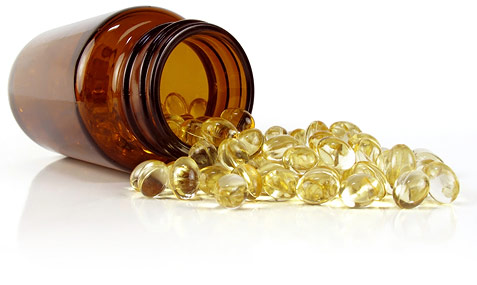Did You Know...
August 24, 2012
Furci Home / Fitness Channel / Bullz-Eye Home
A column by Mike Furci that brings you research, trends and other info to help you with your fitness, health and nutritional needs.
… vitamin D3 levels are related to testosterone levels? By definition, a vitamin is a nutrient that cannot be produced by the body, but is necessary for vital functions of body tissues and organs. Vitamin D is produced in the body when our skin is exposed to ultraviolet light. Because our bodies can manufacture vitamin D, technically it is not a vitamin, but a prehormone. The active form of vitamin D, which our bodies manufacture (called calcitriol) is a hormone. Hormones by definition can activate a cell in two ways: some accomplish this by entering the cell and binding with the DNA in the nucleus; some attach themselves to the cell membrane. Vitamin D (calcitriol) can do both.
As many of you already know from reading my columns, vitamins have a whole host of positive benefits including preventing cancer, heart disease, osteoarthritis, multiple sclerosis, periodontal disease, etc. Well, now it looks as though we can add "increase testosterone" to the list. A Harvard University study examined 1,362 male participants and found a positive association between vitamin D3 levels and free testosterone. The researchers found a linear dose response association between D3 and free testosterone at lower levels (below 75 to 85 nmol/l), reaching a plateau at higher levels.
SOURCE: Clinical Endocrinology, 77: 106 – 12, July 2012 (Paid subscription needed to view full article)

… maximum strength has the strongest influence on muscle endurance? Fernando J. Naclerio and fellow researchers performed a study using 14 firefighters to determine the importance of strength and power on a muscular endurance test. The physical test the firefighters were to perform for a job entry requirement was a maximum repetition test on the flat barbell bench press with 40Kg in 40 seconds.
The subjects performed a progressive test of 8 sets of 2 to 3 repetitions during the first part of the study. The first and second sets were performed using a low load of 25 percent to 45 percent. The first set was always performed with a lower load than the second, which was performed using 40Kg. As subsequent sets were performed, the load was increased. The third and fourth sets were performed with a moderate load of 50 percent to 65 percent of their one-rep maximum (1RM); the fifth and sixth sets were performed with 70 percent to 80 percent of 1RM; and the seventh and eighth sets were performed with 85 percent to 100 percent of 1RM.
To prevent fatigue from being a factor, the second part of the study, which was the max rep test, was performed 72 hours after the first part. Researchers found the 1RM to have the greatest degree of influence in the firefighter's performance on the 40Kg max rep bench press test. Interestingly, the degree of power produced in the progressive test using 40Kg had no correlation with the subject's ability in the max rep test.
SOURCE: J Strength Cond Res.2009;23(5):1482-1488
… testosterone replacement therapy (TRT) has been controversial because of concerns that it raises the risk of prostate cancer? A study of 1,365 men ages 28 to 87 with symptomatic androgen deficiency receiving TRT were monitored for up to 20 years. There were 14 new cases of prostate cancer after 2,966 man-years of treatment, which is one case per 212 years. Researchers concluded the incidence of prostate cancer during long term treatment for TRT was equivalent to the general population. Moreover, TRT with regular monitoring may be safer for men than any other alternative. This is just another study added to a long list touting the safety and efficacy of TRT.
SOURCE: Journal of Sexual Medicine, published online June 6, 2012
 … coffee will not only get you going in the morning, it's good for your prostate? More than 6,000 men were enrolled in a cohort study in the United Kingdom between 1970 and 1973 and followed up to December 31, 2007, to evaluate the association between coffee consumption and prostate cancer incidence. Researchers found that coffee consumption was inversely associated with aggressive high grade prostate cancer, but not the overall risk. Men who consumed three or more cups of coffee per day had a 55 percent lower risk of high grade disease compared to non-coffee drinkers.
… coffee will not only get you going in the morning, it's good for your prostate? More than 6,000 men were enrolled in a cohort study in the United Kingdom between 1970 and 1973 and followed up to December 31, 2007, to evaluate the association between coffee consumption and prostate cancer incidence. Researchers found that coffee consumption was inversely associated with aggressive high grade prostate cancer, but not the overall risk. Men who consumed three or more cups of coffee per day had a 55 percent lower risk of high grade disease compared to non-coffee drinkers.
SOURCE: Nutrition Journal, 11:42, June 13, 2012
… exercise-induced endogenous hormone levels have been studied extensively? Researchers have examined how the different components of training -- including sets, repetitions, load and rest intervals -- affect serum levels of hormones such as testosterone, growth hormone (GH) and cortisol. Many studies have demonstrated there is an acute increase in serum levels of anabolic hormones after intense resistance exercise.
To be more specific: high intensity exercise, coupled with short rest intervals, performed with large muscle groups is associated with increases in these hormones when compared to other training methods. Conversely, training small muscle groups (like the biceps) has been shown to have no effect on serum hormone levels. Because of the findings in many studies, training programs have been mistakenly constructed to maximize the post-exercise rise in these hormones based on the assertion that exercise-induced increases in hormones like testosterone and GH will enhance muscle size and strength.
A study from the Kinesiology Department of McMaster University in Canada found that exercise induced-hormone levels had no effect on muscle size or strength after 15 weeks of resistance training.
There is evidence that a minimal basal level of testosterone is required to support strength and hypertrophy gains. Therefore, the hormone-sensitive processes that support muscle anabolism at hypo- and supra-physiological hormone levels are not being activated appreciably by exercise-induced increases in hormone availability, or at least do not result in any measurable enhancement of strength or hypertrophy.
SOURCES: Journal of Applied Physiology 108(1); 2010
Bottomlinefitness.com
You can follow us on Twitter and Facebook for content updates. Also, sign up for our email list for weekly updates and check us out on Google+ as well.













